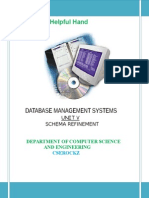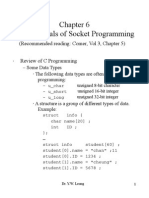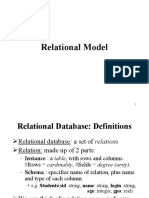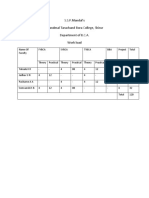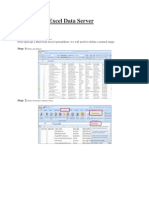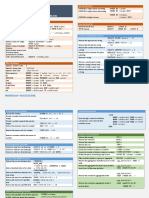Microsoft Activex Data Objects.: Sqlconnection Sqlcommand Sqldatareader SQL System - Data.Sqlclient
Microsoft Activex Data Objects.: Sqlconnection Sqlcommand Sqldatareader SQL System - Data.Sqlclient
Uploaded by
pacharneajayCopyright:
Available Formats
Microsoft Activex Data Objects.: Sqlconnection Sqlcommand Sqldatareader SQL System - Data.Sqlclient
Microsoft Activex Data Objects.: Sqlconnection Sqlcommand Sqldatareader SQL System - Data.Sqlclient
Uploaded by
pacharneajayOriginal Description:
Original Title
Copyright
Available Formats
Share this document
Did you find this document useful?
Is this content inappropriate?
Copyright:
Available Formats
Microsoft Activex Data Objects.: Sqlconnection Sqlcommand Sqldatareader SQL System - Data.Sqlclient
Microsoft Activex Data Objects.: Sqlconnection Sqlcommand Sqldatareader SQL System - Data.Sqlclient
Uploaded by
pacharneajayCopyright:
Available Formats
What is ADO.NET?
ADO.NET is not a different technology. ADO.NET, as a set of classes (Framework) that can be
used to interact with data sources like Databases and X! files. ADO stands for icrosoft Acti"eX
Data Ob#ects.
What are .NET Data Providers?
Databases onl$ understand %&!. 'f a .NET a((lication ()eb, )indows, *onsole etc.) has to retrie"e
data, then the a((lication needs to
1. *onnect to the Database
2. +re(are an %&! *ommand
3. E,ecute the *ommand
4. -etrie"e the results and dis(la$ in the a((lication
a!"le ADO.NET code to connect to #$ erver Data%ase and retrieve data .
Notice that we are usin. #$&onnection, #$&o!!and and #$Data'eader classes.
All the ob#ects are (refi,ed with the word #$.
All these classes are (resent in yste!.Data.(l&lient names(ace.
%o, we can sa$ that the .NET data "rovider for #$ erver is yste!.Data.(l&lient.
%/l*onnection con 0 new %/l*onnection(1data source0.2 database0%am(le2 inte.rated
securit$0%%+'1)2
%/l*ommand cmd 0 new %/l*ommand(1%elect 3 from tbl+roduct1, con)2
con.O(en()2
%/lData-eader rdr 0 cmd.E,ecute-eader()2
4rid5iew6.Data%ource 0 rdr2
4rid5iew6.Data7ind()2
con.*lose()2
Different .NET Data Providers
Data +ro"ider for %&! %er"er 8 %$stem.Data.%/l*lient
Data +ro"ider for Oracle 8 %$stem.Data.Oracle*lient
Data +ro"ider for O!ED7 8 %$stem.Data.OleDb
Data +ro"ider for OD7* 8 %$stem.Data.Odbc
Please note that) de"ending on the "rovider, the followin. ADO.NET ob#ects ha"e a different (refi,
6. &onnection 8 %&!*onnection, Oracle*onnection, OleDb*onnection, Odbc*onnection etc
9. &o!!and 8 %&!*ommand, Oracle*ommand, OleDb*ommand, Odbc*ommand etc
:. Data'eader 8 %&!Data-eader, OracleData-eader, OleDbData-eader, OdbcData-eader etc
;. DataAda"ter 8 %&!DataAda(ter, OracleDataAda(ter, OleDbDataAda(ter, OdbcDataAda(ter etc
The Dataet o%*ect is not "rovider s"ecific. Once we connect to a Database, e,ecute command,
and retrie"e data into .NET a((lication. The data can then be stored in a Data%et and work
inde(endentl$ of the database.
#$&onnection in ADO.NET
<nderstand about the followin. ob#ects.
1. *onnection
2. *ommand
3. Data-eader
4. DataAda(ter
+. Data%et
&onnection, &o!!and, Data'eader and DataAda"ter ob#ects are (ro"iders s(ecific
and Dataet is (ro"ider inde(endent.
The first thing that ,e ,ill have to do, when workin. with databases is to create a connection
ob#ect. There are 9 wa$s to create an instance of (l&onnection class as shown below.
1- &reate an instance of (l&onnection class .sing the constr.ctor that ta/es
&onnectiontring "ara!eter
%/l*onnection connection 0 new %/l*onnection(1data source0.2 database0%am(leD72
inte.rated securit$0%%+'1)2
2- ==First create an instance of %/l*onnection class usin. the (arameter8less constructor
%/l*onnection connection 0 new %/l*onnection()2
==Then set the *onnection%trin. (ro(ert$ of the connection ob#ect
connection.*onnection%trin. 0 1data source0.2 database0%am(leD72 inte.rated
securit$0%%+'12
To create a connection o%*ect ,ith ,indo,s a.thentication
strin. *onnection%trin. 0 1data source0.2 database0%am(leD72 inte.rated securit$0%%+'12
To create a connection o%*ect ,ith #$ erver a.thentication
strin. *onnection%trin. 0 1data source0.2 database0%am(leD72 user id0$<serName2
(assword0$+assword12
The 0data so.rce0 is the na!e or 1P Address of the #$ erver that we want to connect to. 'f $ou
are workin. with a local instance of s/l ser"er, $ou can #ust s(ecif$ DOT (.). 'f the ser"er is on a
network, then use Name or '+ address.
a!"le ADO.NET code that
1. *reates a connection
2. The created connection ob#ect is then (assed to the command ob#ect, so that the command ob#ect
knows on which s/l ser"er connection to e,ecute this command.
3. E,ecute the command, and set the command results, as the data source for the .rid"iew control.
4. *all the Data7ind() method
+. *lose the connection in the finall$ block. *onnections are limited and are "er$ "aluable.
*onnections must be closed (ro(erl$, for better (erformance and scalabilit$.
Note2 *onnections should be o(ened as late as (ossible, and should be closed as earl$ as (ossible
(rotected "oid +a.e>!oad(ob#ect sender, E"entAr.s e)
?
==*reate the connection ob#ect
%/l*onnection connection 0 new %/l*onnection30data so.rce4.5 data%ase4a!"le6Test6D75
integrated sec.rity4P10-55
tr$
?
== +ass the connection to the command ob#ect, so the command ob#ect knows on which
== connection to e,ecute the command
(l&o!!and c!d 4 ne, (l&o!!and30elect 8 fro! t%lProd.ct1nventory0) connection-5
== O(en the connection. Otherwise $ou .et a runtime error. An o(en connection is
== re/uired to e,ecute the command
connection.O"en3-5
9rid:ie,1.Datao.rce 4 c!d.E;ec.te'eader3-5
9rid:ie,1.Data7ind3-5
@
catch (E,ce(tion e,)
?
== Aandle E,ce(tions, if an$
@
finall$
?
== The finall$ block is .uaranteed to e,ecute e"en if there is an e,ce(tion.
== This ensures connections are alwa$s (ro(erl$ closed.
connection.&lose3-5
@
@
We can also .se 0.sing0 state!ent to "ro"erly close the connection as sho,n %elo,.
)e donBt ha"e to e,(licitl$ call &lose3- method, when .sing is used. The connection will be
automaticall$ closed for us.
(rotected "oid +a.e>!oad(ob#ect sender, E"entAr.s e)
?
.sing 3(l&onnection connection 4 ne, (l&onnection30data so.rce4.5
data%ase4a!"le6Test6D75 integrated sec.rity4P10--
?
%/l*ommand cmd 0 new %/l*ommand(1%elect 3 from tbl+roduct'n"entor$1, connection)2
connection.O(en()2
4rid5iew6.Data%ource 0 cmd.E,ecute-eader()2
4rid5iew6.Data7ind()2
@
@
(l&o!!and &lass2
%/l*ommand class is used to (re(are an %&! statement or %tored+rocedure that we want to e,ecute
on a %&! %er"er database.
The follo,ing are the !ost co!!only .sed !ethods of the (l&o!!and class.
1- E;ec.te'eader 8 -eturns more than a single val.e.
2- E;ec.teNon#.ery 8 +erform an 1nsert) <"date or Delete o(eration
3- E;ec.tecalar 8 -eturns a single 3scalar- val.e.
)e will be usin. t%lProd.ct1nventory table for our e,am(les. The table is shown below for $our
reference.
t%lProd.ct1nventory
6) ExecuteReader: returns multi(le rows of data usin. E;ec.te'eader() method.
(rotected "oid +a.e>!oad(ob#ect sender, E"entAr.s e)
?
.sing 3(l&onnection connection 4 ne, (l&onnection30data so.rce4.5
data%ase4a!"le6Test6D75 integrated sec.rity4P10--
?
==*reate an instance of %/l*ommand class usin. the (arameter less constructor
(l&o!!and c!d 4 ne, (l&o!!and3-5
==%(ecif$ the command, we want to e,ecute usin. the *ommandTe,t (ro(ert$
c!d.&o!!andTe;t 4 0elect 1d)Prod.ctNa!e)#.antityAvaila%le fro!
t%lProd.ct1nventory05
==%(ecif$ the connection, on which we want to e,ecute the command
==usin. the *onnection (ro(ert$
c!d.&onnection 4 connection5
connection.O"en3-5
==%&! statement that we want to e,ecute return multi(le rows of data,
==use E,ecute-eader() method of the command ob#ect.
9rid:ie,1.Datao.rce 4 c!d.E;ec.te'eader3-5
9rid:ie,1.Data7ind3-5
@
@
9) E;ec.tecalar3- !ethod2 statement returns a sin.le "alue
(rotected "oid +a.e>!oad(ob#ect sender, E"entAr.s e)
?
.sing 3(l&onnection connection 4 ne, (l&onnection30data so.rce4.5
data%ase4a!"le5 integrated sec.rity4P10--
?
==*reate an instance of %/l*ommand class, s(ecif$in. the T8%&! command
==that we want to e,ecute, and the connection ob#ect.
(l&o!!and c!d 4 ne, (l&o!!and30elect &o.nt31d- fro! t%lProd.ct1nventory0)
connection-5
connection.O"en3-5
==statement that we want to e,ecute return a sin.le "alue,
==use E,ecute%calar() method of the command ob#ect.
==%ince the return t$(e of E,ecute%calar() is ob#ect, we are t$(e castin. to int datat$(e
int Total'o,s 4 3int-c!d.E;ec.tecalar3-5
'es"onse.Write30Total 'o,s 4 0 = Total'o,s.Totring3--5
@
@
:) The follo,ing e;a!"le "erfor!s an 1nsert) <"date and Delete o"erations on a %&!
ser"er database usin. the E,ecuteNon&uer$() method of the %/l*ommand ob#ect.
(rotected "oid +a.e>!oad(ob#ect sender, E"entAr.s e)
?
usin. (%/l*onnection connection 0 new %/l*onnection(1data source0.2
database0%am(le>Test>D72 inte.rated securit$0%%+'1))
?
==*reate an instance of %/l*ommand class
==that we want to e,ecute, and the connection ob#ect.
(l&o!!and c!d 4 ne, (l&o!!and30insert into t%lProd.ct1nventory val.es 31>3) ?A""le?)
1>>-0) connection-5
connection.O"en3-5
==%ince we are (erformin. an insert o(eration, use E,ecuteNon&uer$()
==method of the command ob#ect. E,ecuteNon&uer$() method returns an
==inte.er, which s(ecifies the number of rows inserted
int ro,sAffected 4 c!d.E;ec.teNon#.ery3-5
-es(onse.)rite(1'nserted -ows 0 1 C rowsAffected.To%trin.() C 1Dbr=E1)2
==%et to *ommandTe,t to the u(date /uer$. )e are reusin. the command ob#ect,
==instead of creatin. a new command ob#ect
c!d.&o!!andTe;t 4 0."date t%lProd.ct1nventory set #.antityAvaila%le 4 1>1 ,here 1d 4
1>105
==use E,ecuteNon&uer$() method to e,ecute the u(date statement on the database
rowsAffected 0 cmd.E,ecuteNon&uer$()2
-es(onse.)rite(1<(dated -ows 0 1 C rowsAffected.To%trin.() C 1Dbr=E1)2
==%et to *ommandTe,t to the delete /uer$. )e are reusin. the command ob#ect,
==instead of creatin. a new command ob#ect
c!d.&o!!andTe;t 4 0Delete fro! t%lProd.ct1nventory ,here 1d 4 1>205
==use E,ecuteNon&uer$() method to delete the row from the database
rowsAffected 0 cmd.E,ecuteNon&uer$()2
-es(onse.)rite(1Deleted -ows 0 1 C rowsAffected.To%trin.() C 1Dbr=E1)2
@
@
You might also like
- Database Programming StandardsDocument10 pagesDatabase Programming StandardsSabari NathanNo ratings yet
- SQL, PL/SQL Faq About Triggers:: Insert Update DeleteDocument25 pagesSQL, PL/SQL Faq About Triggers:: Insert Update DeleteSunil ReddyNo ratings yet
- Dotnet QuesansDocument7 pagesDotnet QuesansAravind BhomboreNo ratings yet
- Command: Sqlcommand CMD New Sqlcommand ("Select From Tablename",Con)Document2 pagesCommand: Sqlcommand CMD New Sqlcommand ("Select From Tablename",Con)Nikhil ChoudhuryNo ratings yet
- OratopDocument16 pagesOratopjonytapiaNo ratings yet
- Thanks For Downloading. Enjoy The ReadingDocument3 pagesThanks For Downloading. Enjoy The Readingbrahmi_xyzNo ratings yet
- Department of Information TechnologyDocument25 pagesDepartment of Information Technologymyilvahanan85No ratings yet
- Tutorial - Week: 3: IT0206 - Programming in Java LABDocument19 pagesTutorial - Week: 3: IT0206 - Programming in Java LABshadow1dosNo ratings yet
- Codemii Tutorial 10Document6 pagesCodemii Tutorial 10omegaveskoNo ratings yet
- Book IV FaqsDocument12 pagesBook IV Faqsクマー ヴィーンNo ratings yet
- (Embedded SQL) : What SQL Provides To AS/400 ?Document20 pages(Embedded SQL) : What SQL Provides To AS/400 ?dumbledoreaaaaNo ratings yet
- Myproxyclass - Cs Is GeneratedDocument6 pagesMyproxyclass - Cs Is Generatedsunnyyy1986No ratings yet
- RTDBDocument88 pagesRTDBrhvenkatNo ratings yet
- Paging in SQL ServerDocument10 pagesPaging in SQL Serverkt8815No ratings yet
- Find Size of SQL Server Tables and Other Objects With Stored ProcedureDocument4 pagesFind Size of SQL Server Tables and Other Objects With Stored ProceduredivandannNo ratings yet
- PlsqldocDocument21 pagesPlsqldocAbhishekNo ratings yet
- SAS Interview Questions: Arundathi InfotechDocument61 pagesSAS Interview Questions: Arundathi InfotechYogesh NegiNo ratings yet
- Points To Be Discussed: Execution Command Insertion Command Updation Command Deletion Command Select CommandDocument10 pagesPoints To Be Discussed: Execution Command Insertion Command Updation Command Deletion Command Select CommandManish Kumar AeryNo ratings yet
- Mainframe MaterialDocument12 pagesMainframe MaterialSrinivas NidhraNo ratings yet
- Java MCQDocument13 pagesJava MCQAlan Joe100% (1)
- Private Int Numants 0 Numants++Document5 pagesPrivate Int Numants 0 Numants++Kavita KadamNo ratings yet
- Insert, Select, Update & Delete CommandsDocument5 pagesInsert, Select, Update & Delete CommandsVarun RajNo ratings yet
- Chapter 9 Strings and Text I/O: Answer: CorrectDocument7 pagesChapter 9 Strings and Text I/O: Answer: CorrectNinh Lục TốnNo ratings yet
- SDL Lab+Manual+2008+CourseDocument59 pagesSDL Lab+Manual+2008+CourseArunKumar MogaparthiNo ratings yet
- C - Question Paper Quark Media House India Pvt. LTD.: 1. What Is The Output of The Following CodeDocument9 pagesC - Question Paper Quark Media House India Pvt. LTD.: 1. What Is The Output of The Following CodesumikannuNo ratings yet
- 1.1. Otcl Basics: 1.1.1. Assigning Values To VariablesDocument27 pages1.1. Otcl Basics: 1.1.1. Assigning Values To VariablesReetika AroraNo ratings yet
- Microsoft Client Virtualization Strategy White PapeDocument22 pagesMicrosoft Client Virtualization Strategy White PapePavan Krishna ONo ratings yet
- HadoopDocument28 pagesHadoopsayani_mbaNo ratings yet
- Looping Structure in InformaticaDocument12 pagesLooping Structure in InformaticaSushant SharmaNo ratings yet
- Web Technology IT2353Document52 pagesWeb Technology IT2353kiruthishka100% (1)
- Method: Public Class Public Static VoidDocument12 pagesMethod: Public Class Public Static VoidIamSajid JatoiNo ratings yet
- Ctec1801 Pseudo Past Paper For 2011 12 PDFDocument7 pagesCtec1801 Pseudo Past Paper For 2011 12 PDFSteven JacksonNo ratings yet
- PHP and Database Integration With MySQLDocument6 pagesPHP and Database Integration With MySQLabhijitchNo ratings yet
- Lab 5 Functional Programing 2: RecursionDocument3 pagesLab 5 Functional Programing 2: RecursionPhan Minh NhutNo ratings yet
- 98 364 Test Bank Lesson03Document6 pages98 364 Test Bank Lesson03Rodrigo Nuñez100% (2)
- Code - Aster: Opérateur ASSE - MAILLAGEDocument4 pagesCode - Aster: Opérateur ASSE - MAILLAGElbo33No ratings yet
- Dbms Unit-5 NotesDocument27 pagesDbms Unit-5 Notesfather_mother100% (2)
- Oops 2 Marks and 16 MarksDocument72 pagesOops 2 Marks and 16 MarksRanjith KumarNo ratings yet
- Arithmetic and Date Functions: What Is A Function?Document12 pagesArithmetic and Date Functions: What Is A Function?Venky PragadaNo ratings yet
- Operators Variable Management: PHP Quick Reference CardDocument4 pagesOperators Variable Management: PHP Quick Reference CardamridNo ratings yet
- Correct Answer Is: Explanation: Language - Other Persons Who Also Contributed To The Development of Java Are: PatrickDocument20 pagesCorrect Answer Is: Explanation: Language - Other Persons Who Also Contributed To The Development of Java Are: PatrickMary JosephNo ratings yet
- Cs 301 Final Term Solved Paper 2Document14 pagesCs 301 Final Term Solved Paper 2RizwanIlyasNo ratings yet
- Basic Tutorial For Beginners On R: Start - All Programs - Teaching - Math - R 2.7.0Document6 pagesBasic Tutorial For Beginners On R: Start - All Programs - Teaching - Math - R 2.7.0Nikher VermaNo ratings yet
- In Comparison With Oracle 8i, 9i Is Have Lot Many New Features. Important IsDocument241 pagesIn Comparison With Oracle 8i, 9i Is Have Lot Many New Features. Important IsBalaji ShindeNo ratings yet
- Particle Swarm Optimization Using C#Document12 pagesParticle Swarm Optimization Using C#abdulhakimbhsNo ratings yet
- Sample FileDocument9 pagesSample FileBoni CarreraNo ratings yet
- Data StructuresDocument6 pagesData Structuressubbulakshmiv02No ratings yet
- Fundamentals of Socket ProgrammingDocument38 pagesFundamentals of Socket ProgrammingLuis ClarkNo ratings yet
- Space Invaders TutorialDocument38 pagesSpace Invaders TutorialcitisoloNo ratings yet
- Code - Aster: Opérateur DEFI - SQUELETTEDocument8 pagesCode - Aster: Opérateur DEFI - SQUELETTElbo33No ratings yet
- Time Series Forecasting Using Exponential SmoothingDocument18 pagesTime Series Forecasting Using Exponential SmoothingPassmore DubeNo ratings yet
- Navigation Search / Ɛ L D Æ P / Application Protocol IP DirectoryDocument35 pagesNavigation Search / Ɛ L D Æ P / Application Protocol IP DirectorySantosh Kumar PandeyNo ratings yet
- Method: Public Class Public Static VoidDocument11 pagesMethod: Public Class Public Static VoidIamSajid JatoiNo ratings yet
- C# and .NET VTU SyllabusDocument3 pagesC# and .NET VTU SyllabusRoopashree NarendraNo ratings yet
- MAINTEC Mainframe Interview QuestionsDocument27 pagesMAINTEC Mainframe Interview Questionsrajesh99mainframeNo ratings yet
- Adf Entity Object Notes: State and Entity-StateDocument4 pagesAdf Entity Object Notes: State and Entity-Stateparesh.bapnaNo ratings yet
- CNL Oral QuestionsDocument7 pagesCNL Oral QuestionsShree KumarNo ratings yet
- Introduction To DatabaseDocument1 pageIntroduction To DatabasepacharneajayNo ratings yet
- Getting API KeyDocument3 pagesGetting API KeypacharneajayNo ratings yet
- UML DiagramsDocument25 pagesUML DiagramspacharneajayNo ratings yet
- Classification Using Decision TreesDocument0 pagesClassification Using Decision TreespacharneajayNo ratings yet
- Career Management: Survival SkillsDocument31 pagesCareer Management: Survival SkillspacharneajayNo ratings yet
- Welcome: Eniac Institute of Computer ApplicationDocument31 pagesWelcome: Eniac Institute of Computer ApplicationpacharneajayNo ratings yet
- Tutorial UsecasesDocument3 pagesTutorial UsecasesIrina MurgescuNo ratings yet
- Relational ModelDocument17 pagesRelational ModelpacharneajayNo ratings yet
- Temp WorkDocument1 pageTemp WorkpacharneajayNo ratings yet
- C C C C: Agroecology in Action Isidoro Revised 07-30-00Document11 pagesC C C C: Agroecology in Action Isidoro Revised 07-30-00pacharneajayNo ratings yet
- Software EngineeringDocument4 pagesSoftware EngineeringpacharneajayNo ratings yet
- DBC Driver ManagerDocument6 pagesDBC Driver ManagerpacharneajayNo ratings yet
- BCA Semester V and VIDocument18 pagesBCA Semester V and VIpacharneajayNo ratings yet
- Use Case ModelingDocument31 pagesUse Case ModelingpacharneajayNo ratings yet
- Syntax Basis DataDocument4 pagesSyntax Basis DataFADILLA KHAIRUNNISA PENDIDIKAN GEOGRAFINo ratings yet
- Scholar Register by Nisha VermaDocument5 pagesScholar Register by Nisha Vermaanon_930629608No ratings yet
- Configure Dataguard On Oracle Linux 6-3 by Cornelia Dwi M v1-1Document26 pagesConfigure Dataguard On Oracle Linux 6-3 by Cornelia Dwi M v1-1Dev FitriadyNo ratings yet
- XII - CS - Practical RecordDocument35 pagesXII - CS - Practical RecordAnant Mathew SibyNo ratings yet
- LIONS JUNIOR COLLEGE MANAWAR Krishna Verma 10 TH B Project ITDocument15 pagesLIONS JUNIOR COLLEGE MANAWAR Krishna Verma 10 TH B Project ITkrishnaverma94525No ratings yet
- TK0-201 EXAM MockupDocument230 pagesTK0-201 EXAM MockupAlberto ValentiNo ratings yet
- Database Security Concepts & Attacks: Prepared By: Ruba ArdahDocument65 pagesDatabase Security Concepts & Attacks: Prepared By: Ruba ArdahBrandet ShopNo ratings yet
- Lecture 07 NormalizationDocument50 pagesLecture 07 NormalizationMunira Akter LataNo ratings yet
- The SELECT TOP Clause Is Used To Specify The Number of Records To ReturnDocument5 pagesThe SELECT TOP Clause Is Used To Specify The Number of Records To ReturnManoharNo ratings yet
- CS403 P Lab Manual 1Document52 pagesCS403 P Lab Manual 1Tiktok XeNo ratings yet
- E Hanaaw 18-DemoDocument5 pagesE Hanaaw 18-DemoAditya GuptaNo ratings yet
- ODIDocument51 pagesODIRamu PentapatiNo ratings yet
- Thiru DBMS Viva-FAQsDocument13 pagesThiru DBMS Viva-FAQsdmprashanth6No ratings yet
- Data Modeling With Amazon DocumentDBDocument46 pagesData Modeling With Amazon DocumentDBRoger SenaNo ratings yet
- Loader™: The T24™ Reporting and Data Warehouse SolutionDocument4 pagesLoader™: The T24™ Reporting and Data Warehouse SolutionConcern ShokoNo ratings yet
- Oracle Programming - SQL CheatsheetDocument22 pagesOracle Programming - SQL CheatsheetRahulRoy100% (1)
- DBMS Material Unit 1Document55 pagesDBMS Material Unit 1bhavanapulidindiNo ratings yet
- MCS 043Document34 pagesMCS 043Pooja KumariNo ratings yet
- Chapter 3Document103 pagesChapter 3Lementha YenNo ratings yet
- Join in MySQLDocument6 pagesJoin in MySQLBalakrishna Allu100% (1)
- Exam Questions 1z0-082: Oracle Database Administration IDocument8 pagesExam Questions 1z0-082: Oracle Database Administration Iahmed.abdeen982No ratings yet
- Chapter 05-2 ER-EER To Relational MappingDocument27 pagesChapter 05-2 ER-EER To Relational MappingFantasypie 888No ratings yet
- Presentation of Computer Institute Management SystemDocument24 pagesPresentation of Computer Institute Management SystemMuthumeenatchi UNo ratings yet
- Data Analysis With SQL: Mysql Cheat SheetDocument4 pagesData Analysis With SQL: Mysql Cheat SheetHarshNo ratings yet
- DML AdvancedDocument18 pagesDML AdvancedNguyễn Tùng AnhNo ratings yet
- Database Systems Model Exam QuestionDocument4 pagesDatabase Systems Model Exam Questionkaleb123 shumu12No ratings yet
- Unit 04 - Database Design and Development - Reworded (2021)Document15 pagesUnit 04 - Database Design and Development - Reworded (2021)Supun KaushalyaNo ratings yet
- Exam c2090-312Document24 pagesExam c2090-312amirNo ratings yet
- Adding Database Tables and Data To A Mysql Database: Their Respective OwnersDocument5 pagesAdding Database Tables and Data To A Mysql Database: Their Respective OwnersAyu LestariNo ratings yet
- SQL Assignment 1Document15 pagesSQL Assignment 1Nikhil RaiNo ratings yet




































